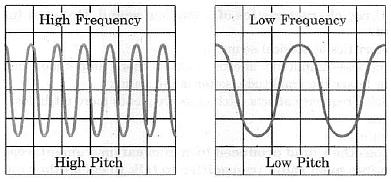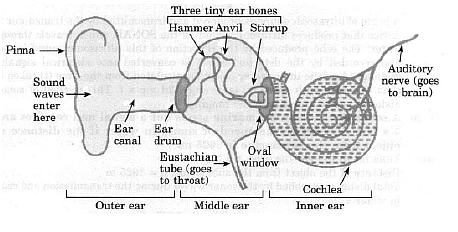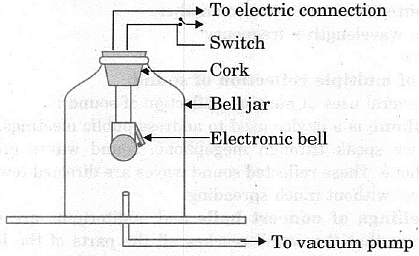Class 9 Science Chapter 11 Question Answers - Sound
Q1: (i) Draw the sound waves for a low pitched and the high pitched sound.
(ii) Write one use of ultrasonography.
(iii) Which wave property determines pitch?
Ans:
(i) The diagram is as shown: Frequency of sound wave(ii) Ultrasonography is used for examination of the fetus during pregnancy to detect congenital defects and growth abnormalities.
Frequency of sound wave(ii) Ultrasonography is used for examination of the fetus during pregnancy to detect congenital defects and growth abnormalities.
(iii) The pitch depends on frequency.
Q2: The stem of a tuning fork is pressed against a table top. Answer the following questions :
(i) Would the above action produce any audible sound?
(ii) Does the above action cause the table to set into vibrations?
(iii) If the answer above is yes, what type of vibrations are they?
(iv) Under what conditions does the above action lead to resonance?
Ans:
(i) Yes, there is an audible sound produced.
(ii) Yes, the table top is set into ‘forced vibrations’ by this.
(iii) The vibrations are forced vibrations.
(iv) P ressing the stem of a vibrating tuning fork against a table top, would lead to resonance if the frequency of the tuning fork equals the natural frequency of oscillations of the table top.
Q3: How does the sound produced by a vibrating object in a medium reach your ear?
Ans : When a vibrating object moves forward, it pushes and compresses the air in front of it creating a region of high pressure called compression. This compression starts to move away from the vibrating object. When vibrating object moves backwards, it creates a region of low pressure called refraction. As the object moves forth and back rapidly, a series of compressions and refractions are created in the air. These produce the sound wave that propagates through the medium. This continues until the sound wave reaches to the ear of the listener.
Q4: Write conditions for the production of an echo.
Ans: Conditions for the production of an echo are :
(i) Time gap between the original sound and the reflected sound. The echo will be heard if the original sound reflected by an obstacle reaches our ears after 0.1 s.
(ii) Distance between the source of sound and obstacle. Thus, the minimum distance (in air at 25°C) between the observer and the obstacle for the echo to be heard clearly should be 17.2 m.
(iii) Nature of the obstacle : For the formation of an echo, the reflecting surface or the obstacle must be rigid such as a building, hill or a cliff.
(iv) Size of the obstacle : Echoes can be produced if the size of the obstacle reflecting the sound is quite large.
Q5: With the help of a labelled diagram show that sound needs a material medium for its propagation.
Ans: A well labelled diagram is as shown :
 Bell jar experiment
Bell jar experiment
(i) Take an electric circuit which consists of a cell, a switch and an electric bell arranged inside a bell jar, which stands on the platform of an evacuating pump.
(ii) The switch of the bell is pressed to close the electric circuit. When there is air within the bell jar, sound is heard. Air is now pumped out of the bell jar. When the air is completely removed from the bell jar, no sound is heard as it is obvious from fig. because the medium of air which has to carry energy from the bell to the bell jar is removed. It shows that sound needs material medium for its propagation.
Q6: A particular transmitter of Aakashvani broadcasts at 420.5 m wavelength. (Given the speed of radio waves 3 × 108 ms–1) Calculate the frequency at which the radio station broadcasts its program. What is the direction of oscillations of the medium particles through which a :
(i) Transverse w ave is propagating?
(ii) Longitudinal wave is propagating?
Ans:
Given
λ = 420.5 m, v = 3 × 108 ms–1, n = ?
Using the expression v = nλ
= 7 × 105 Hz
(i) The particles oscillate perpendicular to the direction of propagation of the wave.
(ii) The particles oscillate parallel to the direction of propagation of the wave.
Q7: (i) State two characteristics of wave motion.
(ii) W hat is the relation between frequency, wavelength and speed of a wave?
Ans:
(i) A w ave motion is periodic in nature. The particles of the medium do not move from their mean position but execute vibration but only the energy is transmitted from one point to another.
(ii) Speed = wavelen gth × frequency
v = λ x v
Q8:Give uses of multiple reflection of sound.
Ans: There are several uses of multiple reflection of sound :
(i) Megaphone is a device used to address public meetings. It is horn-shaped. When we speak through megaphone, sound waves are reflected by the megaphone. These reflected sound waves are directed towards the people (or audience) without much spreading.
(ii) The ceilings of concert halls and auditoriums are made curved. This is done so that the sound reaches all the parts of the hall after reflecting from the ceiling. Moreover, these ceilings are made up of sound absorbing materials to reduce the reverberation.
(iii) Stethoscope is a device used by doctors to listen the sound produced by heart and lungs. The sound produced by heart beat and lungs of a patient reaches the ears of a doctor due to multiple reflection of sound.
(iv) Sound boards are curved surfaces (concave) which are used in a big hall to direct the sound waves towards the people sitting in a hall. The speaker is (i.e., source of sound) placed at the focus of the sound board.
(v) Sound waves from the speaker are reflected by die sound board and these reflected waves are directed towards the people (or audience).
(vi) Hearing aid is used by a person who is hard of hearing. The sound waves falling on hearing aid are concentrated into a narrow beam of sound waves by reflection. This narrow beam of sound waves is made to fall on the diaphragm of the ear. Thus, diaphragm of the ear vibrates with large amplitude. Hence, the hearing power of the person is improved.
Q9: Give application of ultrasound (ultrasonic waves).
Ans: Ultrasonic waves have number of uses :
- Ultrasonic vibrations are used for homogenising milk. These vibrations break down the larger particles of the fat present in milk to smaller particles.
- Ultrasonic vibrations are used in dish washing machines. The vibrating detergent particles rub against the dirty utensils and thus, clean them.
- Ultrasonic vibrations produce a sort of depression in rats and cockroaches.
- Ultrasonic vibrations are used to study the growth of foetus in mother’s womb.
- Ultrasonic vibrations are used in relieving pain in joints and muscles.
- Ultrasonic vibrations are used in detecting flaws in articles made from metals. They are also used in finding the thickness of various parts of a metallic component.
Q10: A tuning fork produces 1024 waves in 4 seconds. Calculate the frequency to the tuning fork.
Ans:
As the tuning fork produces 1024 waves in 4 seconds,
hence Frequency of tuning fork,
v = Number of vibration per second
= 1024 / 4
= 256 HZ
|
88 videos|369 docs|67 tests
|

|
Explore Courses for Class 9 exam
|

|

















